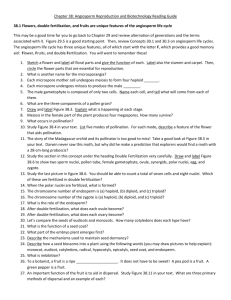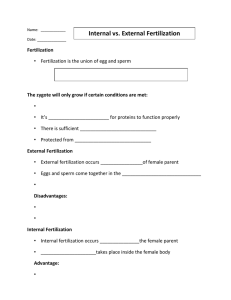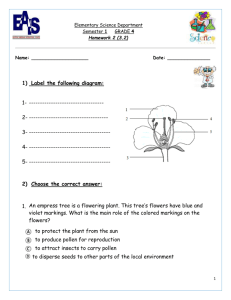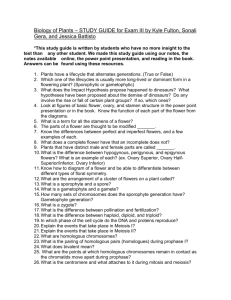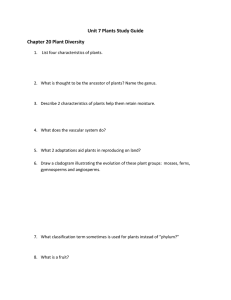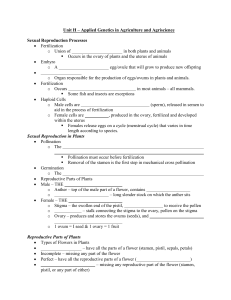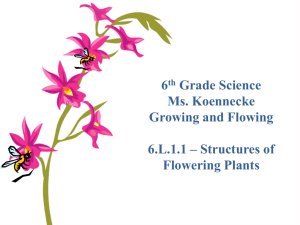Plants + Flower + Pollination + Fertilization www.css.theazkp.com Everyday Science
advertisement
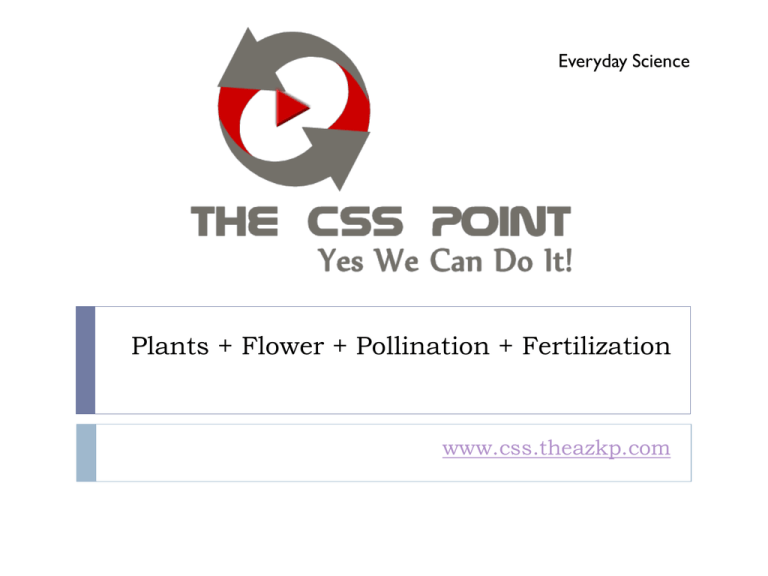
Everyday Science Plants + Flower + Pollination + Fertilization www.css.theazkp.com Plants…… Classification Of Plants: Plants are those organisms which contain chlorophyll and synthesize their own food through photosynthesis. Plants are divided into: 1) Flowering Plants OR Phanerogams 2) Non-Flowering Plants OR Cryptogams 2 Agha Zohaib Khan ::: www.css.theakp.com Flowering Plants: Flowering plants are those plants which contain seed. These are known as Phanerogams. They are further subdivided into: i) Gymnosperms ii) Angiosperms Gymnosperms: Gymnosperms are those flowering plants which contain naked and unprotected seeds. Examples: Pine, Fir, Cedar, Spruce and Cypress etc. Angiosperms: Angiosperms are those flowering plants whose seeds are protected by a fruit or seed pod. Examples: Grass, Crops, Vegetables, Fruits and weeds. 3 Agha Zohaib Khan ::: www.css.theakp.com Non-Flowering Plants: Non-Flowering plants are also known as cryptogams. These are the plants which do not have seed or in other words they are seedless. Following are the main characteristics of these plants: - They reproduce by spores - They have long life - They have no long fibres - They cannot grow to greater size - They generally have simple structure, except ferns. Examples: Moses, Ferns, Algae. 4 Agha Zohaib Khan ::: www.css.theakp.com Flower & Its Parts: The flower is the reproductive part of the plant. It is mainly concerned with formation of seeds. It is regarded as the modified shoot for the purpose of reproduction. Parts Of Flower: A typical flower consists of a short axis known as the thalamus, on which floral leaves are inserted in four distinct whorls, which are as under: i) Calyx ii) Corolla iii) Androecium iv) Gynaecium 5 Agha Zohaib Khan ::: www.css.theakp.com Flower & Its Parts: Calyx: Calyx is the outermost whorl of floral leaves called sepals. The sepals can be defined as the green and leaf like structures which are mainly concerned with the protective function. Corolla: Corolla is the second whorl of floral leaves called petals. The petals are beautifully coloured which are responsible for the attraction to the insects towards them. Androecium: The third whorl of the leaves consists of stamens. It is considered as the male part of the flower. Gynaecium: Gynaecium is the inner most whorl of the floral leaves called carpels. It is considered as the female part of the flower. 6 Agha Zohaib Khan ::: www.css.theakp.com Photosynthesis Definition: Photosynthesis is a process in which plants manufacture their food (simple carbohydrates) in the presence of chlorophyll and sunlight by the combination of carbon dioxide and water. Raw Material For Photosynthesis: i) Carbon dioxide: Taken from air ii) Water: Absorbed by roots from soil iii) Sunlight: From Sun iv) Chlorophyll: green pigment present in leaves By-Products Of Photosynthesis: i) Carbohydrates (simple sugar): used by plants as a food material and excess of it is converted into starch ii) Oxygen: Released into air Importance Of Photosynthesis: i) Major process of food production in plants ii) Utilization of CO2 of the atmosphere and liberation of oxygen iii) Important in reducing CO2 of the atmosphere which is dangerous for the human beings as well as animal health. 7 Agha Zohaib Khan ::: www.css.theakp.com Pollination: It is the process by which seeds are produced. Definition: Pollination is the phenomenon of transfer of pollen from male reproductive organ (anther) to female reproductive organ (stigma) in flowering plants through biological or physical agency. Types Of pollination: There are two types of Pollination i) Self-Pollination: In this type of pollination pollens are transferred to the stigma in the same flower. Some plants are by nature self-pollinated as wheat and grasses. ii) Cross Pollination: In this type the pollen grains are transferred from the anther of one flower to the stigma of another flower. The cross pollination is considered and advantageous to the plant as the seeds produced by cross-pollination are usually greater in number and the plant germinated from them are superior in vigour, height and weight. 8 Agha Zohaib Khan ::: www.css.theakp.com Vehicles For Pollination: Vehicles for pollination are animals, water, wind and insects. Therefore cross pollination may be: a) Entomophily-by insects b) Anemophily-by wind c) Hydrophily-by water d) Zoophily-by animals Importance Of Pollination: • Vital process for reproduction in plants • Reproduction is carried out by reproductory organs of plants due to pollination 9 Agha Zohaib Khan ::: www.css.theakp.com Fertilization: The fusion of male and female gametes is called fertilization. Types Of Fertilization: Following are the major types of fertilization: i) External Fertilization ii) Internal Fertilization iii) Self-Fertilization iv) Cross-Fertilization External Fertilization: • This type of fertilization is generally observed I simple aquatic animals. • In such animals both ova and sperms are released into the water where fertilization occurs. • In terms of evolution external fertilization is of primitive type and is not better biologically as compared to internal fertilization. Internal Fertilization: • In the internal fertilization the females keep ova inside their bodies and males deposit sperms within the tube of reproductive tacts of females. • For all land animals internal fertilization is almost must because sperms are quickly killed by dehydration. • In terms of evolution internal fertilization is highly evolved and much better biologically as compared to external fertilization. 10 Agha Zohaib Khan ::: www.css.theakp.com Self-Fertilization: • Self-fertilization occurs within the same animal. • It is that fertilization in which sperms are used by the ovaries of same animal e.g. Tapeworm Cross-fertilization: • Cross-fertilization is the process in which sperms of one animal are transferred into the body of another animal e.g. Earthworm. 11 Agha Zohaib Khan ::: www.css.theakp.com

